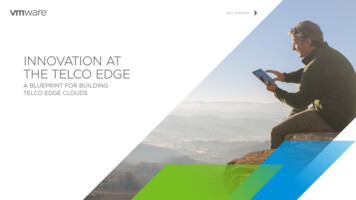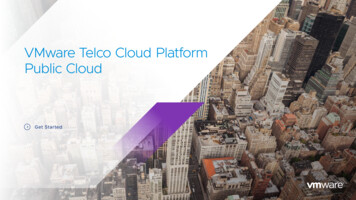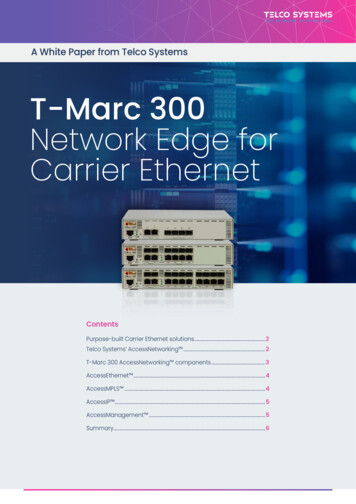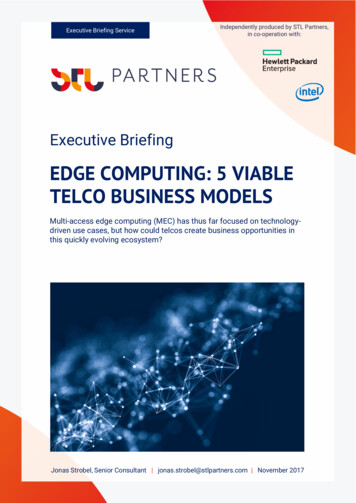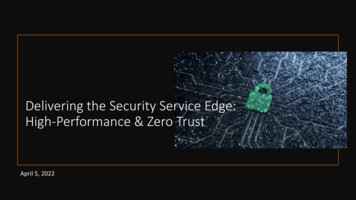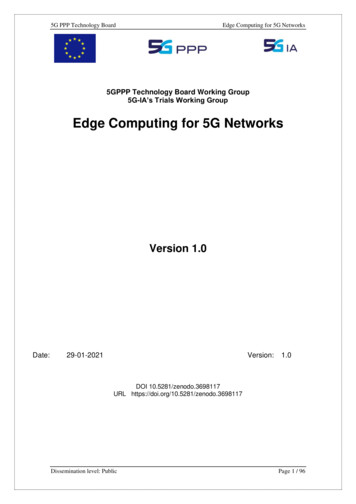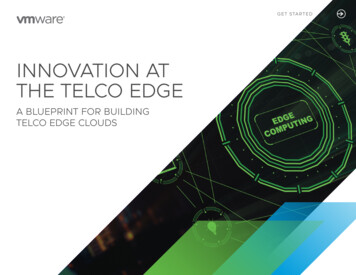
Transcription
G E T S TAR T EDINNOVATION ATTHE TELCO EDGEA BLUEPRINT FOR BUILDINGTELCO EDGE CLOUDS
Defining theTelco EdgeEdge Cloud: ABusiness ImperativeDriving Revenue andValue at the EdgeA Path to DeployingTelco Edge Clouds6 Steps to EdgeCloud ReadinessResources for YourEdge Cloud JourneyDefining the Telco EdgeNew technologies, new business models, new competition—the world of communications serviceproviders (CSPs) is evolving much faster than anyone imagined. With massive data growth, theInternet of Things (IoT), mobile data traffic, and the large number of devices that 5G networks need tosupport, the ability to deploy new services quickly and at scale is becoming key to monetization. Andthis requires the telco infrastructure to be distributed, scalable, and manageable—all characteristics ofa cloud infrastructure that is proving pivotal to business transformation.Traditionally, compute infrastructure has largely been centralized with applications confined to a fewdata centers. This centralized model is extremely efficient for applications that are neither constrainedby high-bandwidth requirements nor latency sensitive, such as the Web or data analysis.AT A GLANCEVMware takes a policy-drivenapproach to deliver a telco edgecloud platform that enablesoperators to develop an end-to-endarchitecture to service applicationsacross core and edge clouds. Theplatform is optimized to deliverenhanced telco services using bothtraditional and microservices-basedapplications, and extend the operatornetwork to third-party applications.In a telco context, however, cloud computing close to the user—edge computing—has severaladvantages for telco services where latency and network performance are strong andtransformational enablers. Moving the cloud closer improves performance in terms of latency, jitter,and bandwidth.Edge computing is necessary for emerging applications, such as for autonomous vehicles, AR/VR,gaming, drones, and IoT, where data is increasingly being produced by the user and needs to beprocessed at low latency from a variety of sources. For other applications such as machine learningand AI, edge computing has economic and performance advantages. (See Figure 1 next page.)INNOVATION AT THE TELCO EDGE2
Defining theTelco EdgeEdge Cloud: ABusiness ImperativeDriving Revenue andValue at the EdgeA Path to DeployingTelco Edge Clouds6 Steps to EdgeCloud ReadinessResources for YourEdge Cloud JourneyEdge clouds apply cloud architecture principles to compute, storage, and networking infrastructure atthe edge of the operator network. Where these network resources are located geographically (centraloffices, public buildings, customer premises, etc.) depends on the specific use case. Deploying andoperating such a distributed cloud environment is complex and requires significant enhancements inthe telco cloud architecture, networking approach, and operations management. In the followingsections, we unwrap these complex requirements and discuss how CSPs can combine the computepower of the cloud with intelligence at the edge of their networks to create a framework for buildingimpactful user experiences.Service AssuranceVNFVNFIntelligent OperationsvPGWVR/ARV2XvUPFUser PlanevRANVNFvEPCvCDNUser PlanevEPCControl PlanevIMSControl PlaneSD-WAN EdgevCloud NFVvCloud NFVvCloud NFVuCPETelco Far EdgeTelco EdgeCore DCAccess RouterAggregation RouterEdge RouterAppsCore RouterEdge Points of PresenceCentral OfficeData CenterAccessAggregation andMetroCoreFIGURE 1. Telco Edge Cloud PlatformINNOVATION AT THE TELCO EDGE3
Defining theTelco EdgeEdge Cloud: ABusiness ImperativeDriving Revenue andValue at the EdgeA Path to DeployingTelco Edge Clouds6 Steps to EdgeCloud ReadinessResources for YourEdge Cloud JourneyEdge Cloud: A Business ImperativeCSPs have several different priorities in their network transformation efforts. Some are modernizing theirexisting architecture and infrastructure as they evolve toward modern, cloud-first principles, while othersare innovating with business models and applications. Whatever the intent and business use case, theyall share the objectives of greater responsiveness and readiness for the needs of the business.The objectives for edge clouds can be categorized broadly under the following business challenges:DRIVE BUSINESS AGILITY AND INNOVATIONCombining agile infrastructure with edge clouds can accelerate business innovation. An agiledevelopment platform requires CSPs to collaborate with vendors on differentiated offerings andrapidly add subscriber features and functionality in response to market opportunities. An agile edgecomputing infrastructure enables rapid scaling that benefits clustered multi-user games orexperiences that share context such as player location and orientation among players located close toone another. Another example is personalized applications enabled by local context. CSPs are alsolooking at alternative business models such as providing a PaaS platform for third-party applications.A modern infrastructure is key to such opportunities as they require the creation of a developercentric edge ecosystems that let developers tap into telco edge APIs and the algorithm economy tocreate innovative and disruptive edge applications.INNOVATION AT THE TELCO EDGE4
Defining theTelco EdgeEdge Cloud: ABusiness ImperativeDriving Revenue andValue at the EdgeA Path to DeployingTelco Edge Clouds6 Steps to EdgeCloud ReadinessResources for YourEdge Cloud JourneyMODERNIZE MULTI-CLOUD NETWORK OPERATIONSThere is an acute focus on increasing the speed of change and improving operational resilience.An integrated operational intelligence framework provides advanced service lifecycle capabilities,monitoring and resilience, and improved operational efficiency by providing an integrated view ofinfrastructure, services and applications. Similarly, efficient workload placement requires real-timeload and available capacity along with collaboration between CSPs and VNF vendors. A prescriptiveset of steps must be followed to package and deploy a VNF with the VNF vendor providing theprerequisites for successful VNF onboarding, including the VNF format, east–west and north–southconnectivity, routing and security policy, and performance requirements. This also requires finegrained resource allocation and control where consistent resource allocation at the edge and coredata center ensures that tenant resources are provisioned and made available as and when requiredby the business.Drive Business Agilityand InnovationModernize Multi-CloudNetwork OperationsEnsure ApplicationPerformance andSecurityAccelerate ApplicationDevelopment andDeliveryFIGURE 2. Top Business Challenges Faced by Communications Service ProvidersINNOVATION AT THE TELCO EDGE5
Defining theTelco EdgeEdge Cloud: ABusiness ImperativeDriving Revenue andValue at the EdgeA Path to DeployingTelco Edge Clouds6 Steps to EdgeCloud ReadinessResources for YourEdge Cloud JourneyENSURE APPLICATION PERFORMANCE AND SECURITYUse of hardware accelerators and DPDK-based workload acceleration greatly enhance applicationperformance and create differentiated customer experiences. Edge computing, however, also greatlyexpands the number of potential access points across the network, and CSPs need tools to providehigher levels of protection. This requires the use of secure cloud gateways, micro-segmentation, andan ecosystem of VNF solutions for networking and security across workloads and tenant switchingand routing fabric. Another aspect that impacts overall security and performance is the necessity toprovide resource isolation and resource guarantees across applications. This requires a secure multitenant environment with dynamic resource allocation. And finally, robust business continuity requiresedge cloud components to implement high availability by default while allowing applications toleverage platform capabilities and extend their availability.ACCELERATE APPLICATION DEVELOPMENT AND DELIVERYIncreased speed of application delivery has become a fundamental business imperative. The industryis coalescing around the use of containers as a unifying platform across development, operations,security, QA and other teams. With a DevOps approach, teams are embracing CI/CD practices andcontainer-based automation to accelerate the app delivery cycle. CSPs can no longer just build edgecloud infrastructure and hope for adoption. They must actively promote software innovation withapplications optimized for a decentralized cloud ecosystem. By providing application developers withthe tools needed to tap into the distributed edge infrastructure, CSPs can promote innovativesolutions that offer enhanced customer experience and better service. Edge solutions, discussed laterin this document, are a critical part of this effort.INNOVATION AT THE TELCO EDGE6
Defining theTelco EdgeEdge Cloud: ABusiness ImperativeDriving Revenue andValue at the EdgeA Path to DeployingTelco Edge Clouds6 Steps to EdgeCloud ReadinessResources for YourEdge Cloud JourneyDriving Revenue and Value at the EdgeCSPs are in prime position to offer their customers the required telco infrastructure that matches therequirements of applications and industry verticals being targeted. Deployment of applications will bebased on whether the application requires ultra-low latency / high-bandwidth characteristics or whetherdata- or resource-intensive applications will require being placed in a centralized data center.A typical telco edge architecture site can be visualized as a three-layer stack that consists of the virtualinfrastructure, telco mobility infrastructure, and application layer. End-user services can run either on topof the application layer or directly on the virtual infrastructure. By running on top of the application layer,end-user applications can leverage the mobility aspects of the infrastructure and provide customizedservices (such as location-based services) to users. The VMware telco edge architecture also allowsapplications to run directly on the virtual infrastructure. A typical use case would be a video broadcastingapplication that pre-processes video from a live event before uploading it to the central media distributionsite. Here, we discuss a few use cases that are seeing widespread telco interest and adoption.APPAPPAPPAPPSOLUTION HIGHLIGHTS 5G-ready platform designed forhigh-bandwidth, ultra-low latencyapplications with support for a largevolume of connections, fixed-mobilenetwork convergence, and a cloudnative stack Hierarchical distributed cloud thatsupports resource pooling, hierarchicalcloud management, business continuityand service localization Simplified manageability andhierarchical operations for fully remotelifecycle management, capacityplanning, issue isolation and closedloop optimization across shared cloudinfrastructure Advanced edge cloud networkingwith hybrid cloud interconnect, latencyoptimized connectivity, dynamicworkload chaining, and N-VDS foruserplane functionsAPPThird-PartyApplicationsTelco MobilityInfrastructurevCloud NFV InfrastructureFIGURE 3. Third-Party Application Deployment OptionsINNOVATION AT THE TELCO EDGE7
Defining theTelco EdgeEdge Cloud: ABusiness ImperativeDriving Revenue andValue at the EdgeA Path to DeployingTelco Edge Clouds6 Steps to EdgeCloud ReadinessResources for YourEdge Cloud JourneyDISTRIBUTED CONTROL AND USER PLANE5G aims to enable applications that consume a large amount of data (e.g., live streaming), provideimmersive experience (e.g., AR/VR), and provide network connectivity to billions of devices (e.g.,IoT) at low latency. These goals necessitate upgrading both the radio network as well as mobile core.On the radio network, there are significant advancements in spectral efficiency and increased data.In the mobile core, there is a push to separate the data plane from the control plane and to deploythe user plane as close to the device as possible to handle massive amounts of data traffic.User Plane FunctionsUser Plane FunctionsControl Plane FunctionsUser Plane FunctionsControl Plane FVNFMMES-GW-CP-GW-UVMware vCloud NFVVMware vCloud NFVEdge NetworkVMware vCloud NFVCore NetworkFIGURE 4. Mobile UPF Realization Using VMware Telco EdgeMobile User Plane Using VMware Telco EdgeFigure 4 depicts the CUPS (control plane and user plane separation) architecture realized with aVMware telco edge architecture. The design for both 4G EPC and 5G positions the control plane inan aggregation site, while the user plane is distributed to the edges. Low latency and low cost ofbackhaul/core transports are critical for supporting massive bandwidth and device density, andINNOVATION AT THE TELCO EDGE8
Defining theTelco EdgeEdge Cloud: ABusiness ImperativeDriving Revenue andValue at the EdgeA Path to DeployingTelco Edge Clouds6 Steps to EdgeCloud ReadinessResources for YourEdge Cloud Journeymobile operators are looking at distributing control plane functions to a few regionally distributedclouds. This model provides operators with a good balance between simpler topology and efficientprocessing. Based on this theme, a typical network is likely to look like the architecture presented inFigure 5. Typically, the user plane functions would be located at the edge sites while managementand control plane functions would be hosted at a core data center.PRIVATE LTE NETWORKSEnterprise applications such as industrial manufacturing, transportation, and smart cities havetraditionally relied on Wi-Fi and fixed-line services for connectivity and communications. Thesenetworks have been unreliable and costly while also being difficult to scale. However, CSPs can nowoffer cellular services such as private LTE to these market verticals. Private LTE does not rely ontraditional macro network services but can instead use CBRS or low-cost TDD spectrum forconnectivity, built on a dedicated on-premises telco edge and a centralized control plane.CSPs are deployingdedicated mobile networks(4G and/or 5G) at theenterprise site to overcomeconnectivity challenges.Private LTE Using VMware Telco EdgeAs real-time analytics and automation become increasingly common in manufacturing, reliable andscalable wireless communication is becoming critical to the business. Enterprises have so far reliedon Wi-Fi based technologies to meet their needs. Wi-Fi, however, presents several challenges insuch an environment, including issues with in-building coverage, uninterrupted roaming, and sessioncontinuity from inside the premises to outside.CSPs are deploying dedicated mobile networks (4G and/or 5G) at the enterprise site to overcomeconnectivity challenges. Making the site completely self-sufficient requires enterprise deployments toinclude all data plane and control plane components needed to manage a scaled-out telco networkwhere mobile sessions do not leave the enterprise premises unless necessary. In addition, enterprisesmay deploy additional applications at the edge site with the option to connect the edge directly to theenterprise IT cloud. For example, a factory floor can be automated to provide private LTE services torobotics equipment, remote operations, and content storage and distribution with the sameconsistent VMware Telco Cloud Infrastructure and capabilities.INNOVATION AT THE TELCO EDGE9
Defining theTelco EdgeEdge Cloud: ABusiness ImperativeDriving Revenue andValue at the EdgeA Path to DeployingTelco Edge Clouds6 Steps to EdgeCloud ReadinessResources for YourEdge Cloud JourneyA Path to Deploying Telco Edge CloudsVMWARE TELCO EDGE DESIGN PRINCIPLESVMware’s Telco Edge architecture outlines a distributed cloud model to support edge applications and isbased on VMware’s Telco Cloud Infrastructure platform.Common PlatformVMware provides a flexible deployment architecture based on a common infrastructure platform that isoptimized for deployments across edge and core data centers. With centralized management and asingle pane of glass for monitoring network infrastructure across the multiple clouds, CSPs will haveconsistent networking, operations and management across their cloud infrastructure.Centralized ManagementThe VMware Telco Edge architecture is designed to have a centralized VMware Integrated OpenStackVIM (virtual infrastructure manager) at the core data center while the edge sites do not need to have anyOpenStack instances. With zero OpenStack components present at the edge sites, CSPs will gainmassive improvements in network manageability, upgrades, scale and operational overhead.This centralized management at the core data center gives CSPs access to all the edge sites withouthaving to connect to individual edge sites to manage their resources.Multi-Tenancy and Advanced NetworkingLeveraging the existing VMware Telco Cloud Infrastructure design, the telco edge architecturecan be deployed in a multi-tenant environment with resource guarantees and resource isolation witheach tenant having an independent view of their network and capacity and management of theirunderlying infrastructure and overlay networking. The edge sites support overlay networkingwhich makes them easier to configure and offers zero trust through NSX micro-segmentation.INNOVATION AT THE TELCO EDGE10
Defining theTelco EdgeEdge Cloud: ABusiness ImperativeDriving Revenue andValue at the EdgeA Path to DeployingTelco Edge Clouds6 Steps to EdgeCloud ReadinessSuperior PerformanceVMware NSX managed virtual distributed switch in enhanced data path mode (N-VDS [E])leverages DPDK techniques to provide the fastest virtual switching fabric on VMware vSphere providing 3–5X performance boost without compromising on key virtualization characteristics suchas using VMware vMotion . Telco user plane functions (UPFs) that require lower latency and higherthroughput at the edge sites can run on hosts configured with N-VDS (E) for enhanced performance.Real-Time Integrated Operational IntelligenceThe ability to locate, isolate and provide remediation capabilities is critical given the variousapplications and services that are being deployed at the edge. In a distributed cloud environment,isolating an issue is further complicated given the nature of the deployments.The telco edge framework uses the same operational model as is deployed in the core network andprovides the capability to correlate, analyze, and enable day 2 operations. This includes providingcontinuous visibility over service provisioning, workload migrations, auto-scaling, elastic networkingand network-sliced multi-tenancy that spans across VNFs, clusters and sites.Far EdgeNear EdgeCore Data CenterSmall footprint for ultra-low latency appsHierarchical control planesEverything in one locationResources for YourEdge Cloud JourneyEfficient VNF Onboardingand PlacementOnce a VNF is onboarded,the tenant admin deploys theVNF to either the core datacenter or the edge datacenter depending on thedefined policies andworkload requirements.VMware Telco Edgearchitecture offers dynamicworkload placement,ensuring the VNF has theright number of resources tofunction efficiently.The VMware Telco Edge SolutionService AssuranceCloud NativeManagementCommon PlatformComputeStorageOptimized and Scalable FootprintNetworkingAdvanced Assurance and IntelligenceFIGURE 5. Telco Edge SolutionINNOVATION AT THE TELCO EDGE11
Defining theTelco EdgeEdge Cloud: ABusiness ImperativeDriving Revenue andValue at the EdgeA Path to DeployingTelco Edge Clouds6 Steps to EdgeCloud ReadinessResources for YourEdge Cloud Journey6 Steps to Edge Cloud ReadinessEdge clouds provide an environment where CSPs can build secure and powerful cloud environmentsthat address the limitation of traditional infrastructure. However, moving from centralized to edge cloudarchitectures can be complex. Here, we describe a set of initiatives a CSP should undertake to evolve toa cloud architecture that maximizes the impact of edge clouds.1Establish Clear Objectives. Establish clear objectives and use cases for developing edgeclouds over the short and long term. You should be able to articulate the business value,and clearly identify capabilities and tasks for moving forward.2Understand Your Application Landscape. Analyze the requirements of your applications toidentify those best suited for an edge cloud environment. Consider the need to refactor youron-premises applications for deployment on edge cloud platforms. Applications that areflexible and service oriented can typically leverage the scale-out edge cloud architecture,especially cloud-native applications that are easy to automate, move and scale.3Formulate a Resource Allocation Strategy. Analyze your entire network to form ageographical distribution strategy for your edge clouds and application workloads.This includes identifying the number of end users in each edge geographythat are expected to subscribe to edge services and scaling the edge cloudcapacity accordingly. The goal of this exercise is to avoid systemcomplexity and poor resource utilization by aligning resource allocationwith expected usage patterns and application characteristics suchas the use of VMs and containers.INNOVATION AT THE TELCO EDGE12
Defining theTelco Edge456Edge Cloud: ABusiness ImperativeDriving Revenue andValue at the EdgeA Path to DeployingTelco Edge Clouds6 Steps to EdgeCloud ReadinessAlign People, Processes and Technology. Bring together business, development andoperations and think in terms of people, processes and technology. What needs to changeand why? What would be the effects of migrating an application or group of applications toedge clouds? What changes in staffing or workflows would be required to support this newedge cloud environment? Create a solution architecture that describes how the solutionshould look when it’s fully implemented. The goal is to align and guide those working on theproject. Also consider embracing organization-wide agile methodologies that include theengineering, product management, business development, cloud operations, IT, softwaredelivery and customer support teams.Architect for Scale and Application Availability. A key advantage of deploying edge clouds isincreased application availability and higher service resilience. Clearly articulate an availabilityand disaster recovery strategy and use integrated operations designed for virtualenvironments. Focus on automating policies across clouds such that you have a singlestandard set of policies applied automatically to each cloud. Ensure that the policies coversuch areas as data storage, workloads, traffic flows, virtual servers, compliance, security andreporting and that changes and updates propagate seamlessly from one cloud to another.Deploy and Maintain Strategic Focus. Deploy your cloud resources including applicationsacross the edge clouds while maintaining a unified end-user experience. Implement strategiesfor monitoring capacity utilization and scaling the edge sites dynamically to future-proof thenetwork. And finally, continue to remind those working on the project what the end goal is,why it matters, and how this project contributes to the organization’s strategic goals.Resources for YourEdge Cloud JourneyEstablishClearObjectivesUnderstandYour ApplicationLandscapeFormulate aResourceAllocation StrategyAlign People,Processes andTechnologyArchitect for Scaleand ApplicationAvailabilityDeploy andMaintainStrategic FocusFIGURE 6. Six Steps toEdge Cloud ReadinessINNOVATION AT THE TELCO EDGE13
Resources for Your EdgeCloud JourneyLearn more about how VMware can support your edge cloud journey.For insights, sizing tips, and detailed design and deploymentconsiderations: VMware Edge Reference Architecture for vCloud NFVVMware vCloud NFV platform solution briefVMware vCloud NFV OpenStack Edition datasheetLearn how VMware technologies are enabling the telco cloud at:telco.vmware.comLearn more.Visit telco.vmware.comJoin us online:VMware, Inc. 3401 Hillview Avenue Palo Alto CA 94304 USA Tel 877-486-9273 Fax 650-427-5001 www.vmware.com Copyright 2020 VMware, Inc. All rights reserved.This product is protected by U.S. and international copyright and intellectual property laws. VMware products are covered by one or more patents listed at http://www.vmware.com/go/patents.VMware is a registered trademark or trademark of VMware, Inc. and its subsidiaries in the United States and other jurisdictions. All other marks and names mentioned herein may be trademarksof their respective companies. Item No: VMW-EBOOK-TELCO-USLET-102 02/20
Mobile User Plane Using VMware Telco Edge Figure 4 depicts the CUPS (control plane and user plane separation) architecture realized with a VMware telco edge architecture. The design for both 4G EPC and 5G positions the control plane in an aggregation site, while the user plane is distributed to the edges. Low latency and low cost of


